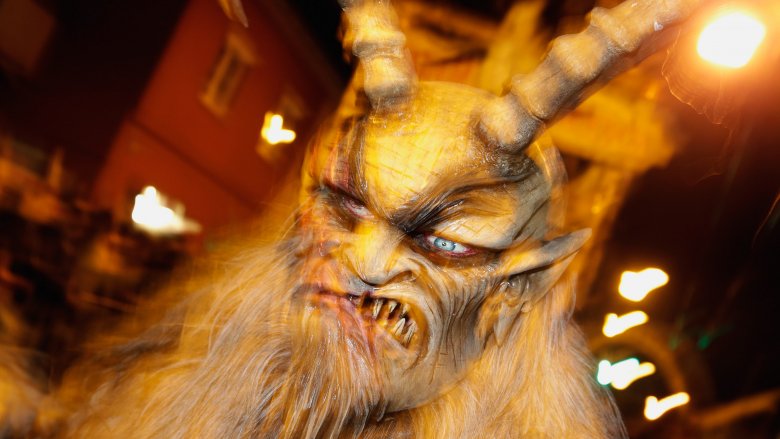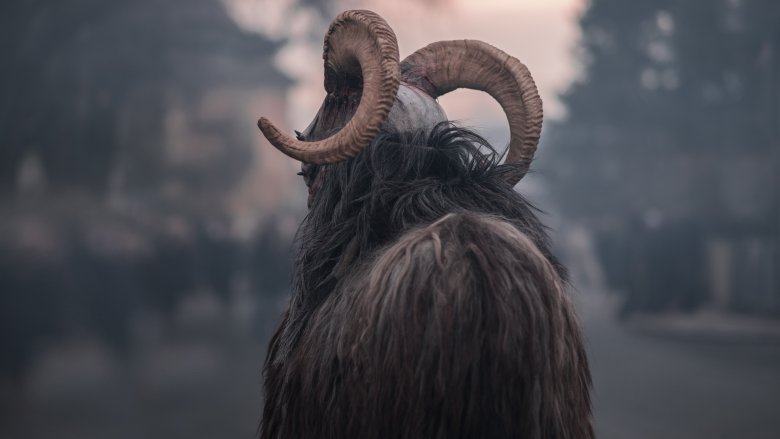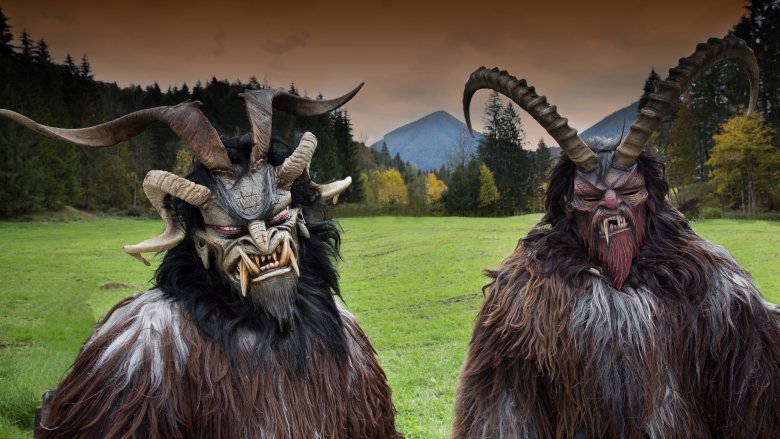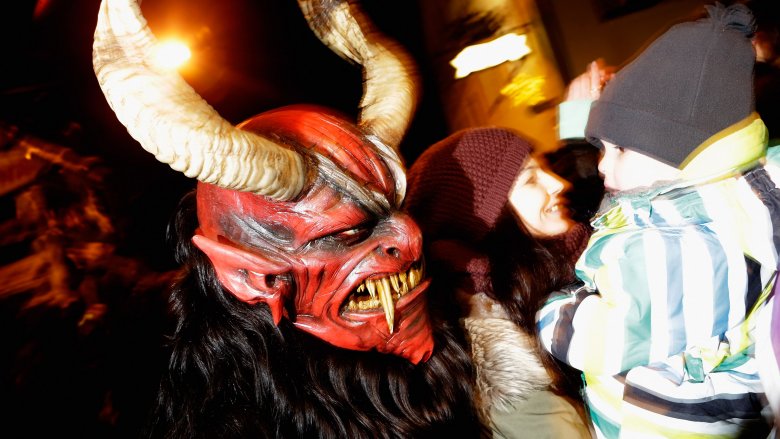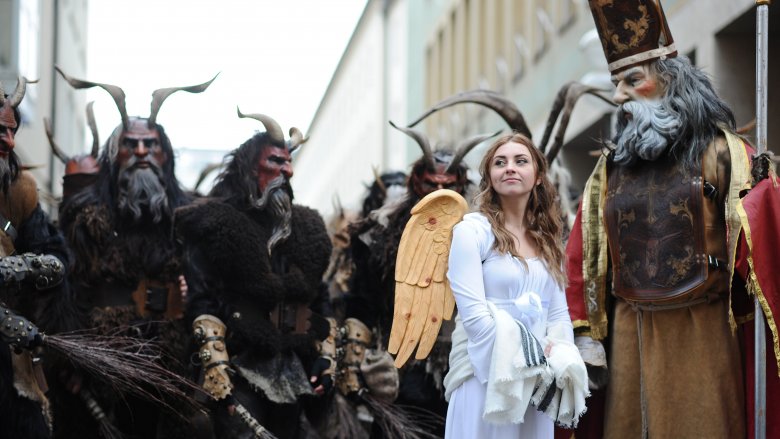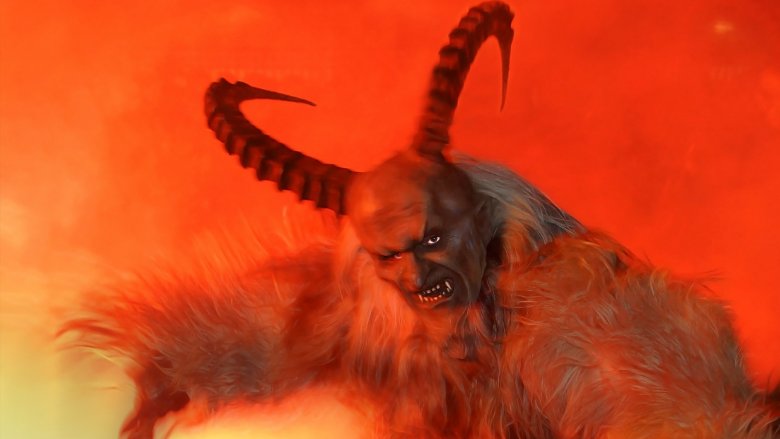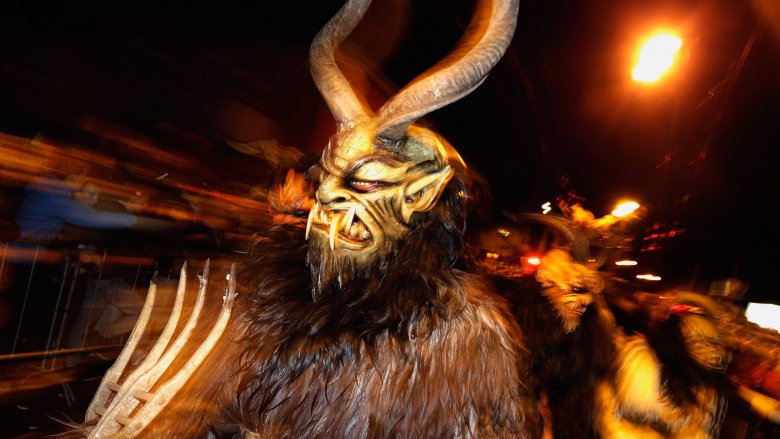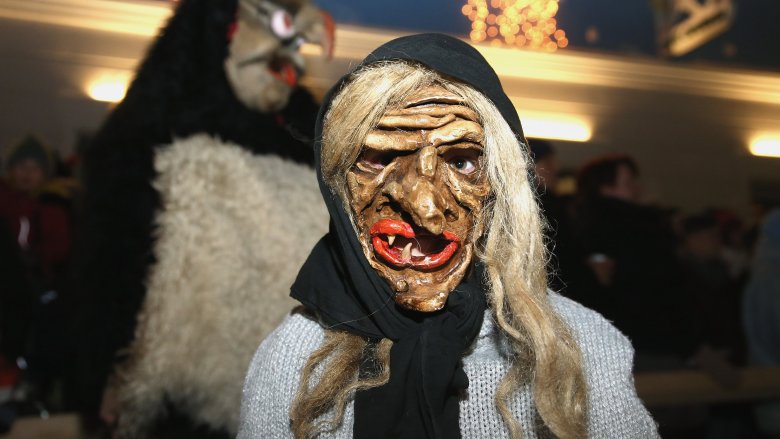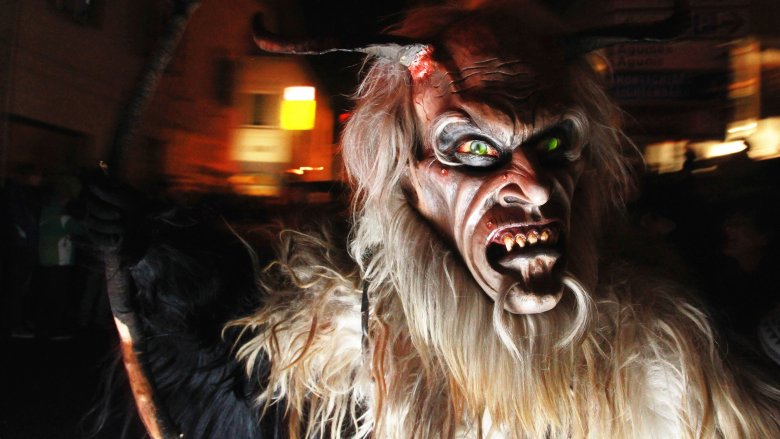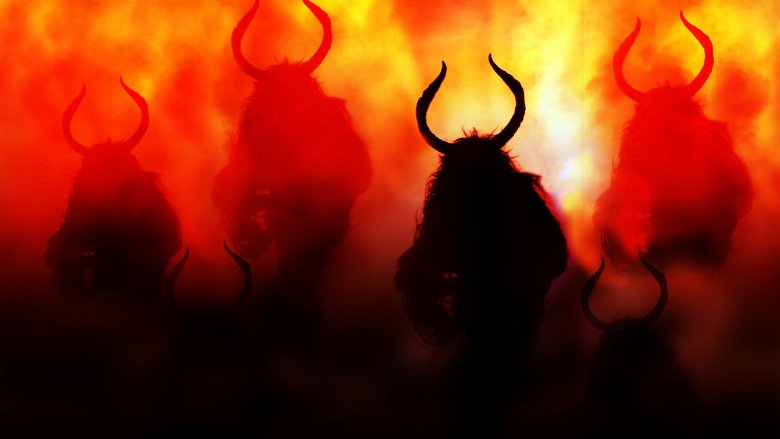The Untold Truth Of Krampus
We may receive a commission on purchases made from links.
You'd better watch out, you'd better not cry ... because Krampus is coming to town. For centuries, stories have been told of a horned demon who walks the winter nights, punishing children who have been bad during the year. Occasionally, he eats them. Krampus has had a major resurgence in popularity in the 21st century, plucked from the Dark Ages and reborn as a reminder of why you should definitely try to be good boys and girls. Here's what you should know about him before he comes tapping at your window.
He has Norse roots
While the traditional Christian Christmas doesn't have much to do with ancient pagan festivals (in spite of what you've been told), Krampus definitely does. He comes from a dark part of history, emerging from ancient pagan religious beliefs in Eastern Europe. According to National Geographic, his name comes from "krampen," the German word for "claw." Weirdly, while he hails from ancient Austria, his origin story is Norse. Tradition says his mother is Hel, the goddess who rules the underworld and the dead.
Hel isn't a huge player in Norse mythology, but her father — Krampus' grandfather — doesn't get much bigger. It's Loki (via Norse Mythology), and if you only know him from the Marvel movies, that's a shame. You're missing out on a ton of weird stuff, and his pack of monstrous children — including Fenrir the wolf and Jormungard the world serpent — must have made family Christmas dinners a hoot. No wonder Krampus grew up like he did.
He's a particular species of creature
Krampus isn't just a one-of-a-kind demon, but Atlas Obscura says there's actually a whole race of them. They're called Perchten, and they developed out of the Alpine pagan folklore that said the long winter months needed to be scared away. Men dressed in animal masks would wander the villages to do just that and over time, those super-scary creatures they were pretending to be developed into the furry, horned beasts we'd recognize today as Krampus.
The practice is so ancient, in fact, that the Perchten are centuries older than jolly old St. Nicholas. They almost disappeared entirely during the Dark Ages, when they were targeted alongside witches for complete and total eradication.
One single Perchten was plucked from the herd and adopted into Christian traditions: Krampus. As early as the 1600s, he was appearing alongside the very Christian St. Nicholas as a polar opposite. He punished while St. Nicholas rewarded, and he became an evil, horrific reminder of just what waited when all people — not just children — were naughty. That was an idea the church could let slide, so Krampus survived while his brethren faded into obscurity.
December 5 is Krampusnacht
Strictly speaking, Krampus isn't even a Christmas demon. Ancient folklore — and National Geographic — says he walked the land on the night of December 5, which was called Krampusnacht. (That's Krampus Night, if you're rusty on your German.) The date wasn't arbitrary; it's the night before Nikolaustag (St. Nicholas Day). December 6 was traditionally the morning all boys and girls — good and bad — would check to see if they'd gotten a present from St. Nicholas or a switch from Krampus.
Krampus is making a comeback in many European countries, and Krampusnacht is once again being celebrated on December 5. Krampus celebrations featuring full Krampus dress and plenty of alcohol are popping up from Krampus' pagan homeland all the way to Michigan, with many Krampusnacht celebrations going intentionally old-school. The earliest Krampus masks were made from wood, and European artisans are making some incredible, one-of-a-kind, handmade masks just for Krampusnacht revelers.
Traditional Krampusnacht were hardcore
Today, most Krampusnacht celebrations are pretty tame, although some people do still get hurt. In 2015, The Independent reported on some Krampus-related injuries at a Salzburg parade, but the old-school celebrations make a few bruises look like a walk in the park.
Journalist Holly Muller looked at some traditional Austrian tales told by her family members over the years (via The Independent), and she says Krampus was a very real threat to kids. Her family told her stories of waiting in the darkness, terrified, hearing the clamor of strange voices coming from outside the window. On that night, they rethought all the life choices they'd made the previous year. Even if you'd been good, there was a very real chance Krampus would burst through your door, grab you and carry you out into the night.
That Krampus was, of course, someone wearing a costume. Muller's father told her it didn't matter even if you knew that. "It was always the waiting that was the worst. The silence before the onslaught," he said. It didn't matter that those people in costume were your neighbors or that they were perfectly normal people every other night of the year. On that night, Krampus was totally real.
He was originally jolly old St. Nick's slave
Do some digging into old Krampus folklore, and you might want to give the poor guy a break. He's usually carrying chains, but not as a threat. He's carrying them because he's a slave, and St. Nicholas is his master.
That's according to Al Ridenour, author of a book about Krampus (via Vice). He says the popular belief about Krampus — that he's punishing kids because that's what Krampus does — is largely wrong. He's only doing what he does because St. Nicholas can't be bothered to get his hands dirty, and those chains are a reminder that he's completely subservient to the will of the more Christian entity. He's a reminder that you can't have good without evil, and maybe it's not his fault he likes his job.
He was said to do some horrible things
Today, the most kids need to worry about is not getting everything on their list, but Krampus had other ideas about how to punish bad behavior. Krampus brought a whole lot of pain, and io9 says his favorite way to deal with the less-than-angelic was to pick up the naughty with his tongue, stuff them in his sack, and carry them home. There, they'd join him for dinner — as the main course.
If they were lucky. Author Al Ridenour (via Vice), says there were other things kids were told they needed to watch out for. Krampus might just torture them a bit before eating them, and even if he didn't decide to take them away, there was still the possibility they'd get an old-fashioned whipping. Finally, if a child wasn't quite palatable enough, he or she might be cast into a frozen lake or dragged to hell instead of being torn to pieces and eaten.
But still, it was framed as just what the child deserved. What goes around comes around, the saying goes, and Krampus is bringing it.
He was the original Elf on the Shelf
Krampus isn't just for Christmas, and he's not just for Krampusnacht, either. Journalist Holly Muller wrote in The Independent that Krampus was a year-round presence, and Austrian kids who even considered misbehaving were reminded what waited for them if Krampus got wind of what they were planning. If a warning didn't work, there was always a friend or neighbor who was more than willing to don the costume and put some good, old-fashioned fear of Krampus into any little troublesome tyke.
According to traditions recorded in They Do What? A Cultural Encyclopedia of Extraordinary and Exotic Customs from around the World, many homes had a constant reminder of Krampus' all-seeing presence. Parents would exchange bundles of birch sticks painted gold and hang them up at home. The bundles, called ruten, were a reminder that there would come a time when consequences would need to be paid for any bad actions, and Elf on the Shelf hasn't got anything on Krampus.
He has a female counterpart
There's a female version of Krampus, and she's called Frau Perchta, Berta, Berchte, and even Hulda, depending on the region. She never entirely made the leap into Christianity like Krampus did, and that's probably because she's both sides on the coin of good and evil. Author Al Ridenour writes that she was both a monster and a goddess figure, both hideous and beautiful, both Krampus and St. Nicholas.
Even though she hasn't achieved the same level of popularity as Krampus, her terrifying, traditional appearances during the 12 days of Christmas were recorded by folklorist Jacob Grimm. He says she was known for giving silver coins to good boys and girls, while the bad ones would be sliced open, disemboweled, and re-stuffed with straw and rocks. Merry Christmas.
She makes the occasional appearance at Krampusnacht celebrations even today, and she's just as terrifying now as she was then.
His U.S. popularity is a recent phenomenon
Krampus has always been the subject of tales told in Eastern Europe, and by the end of the 19th century, his demonic image was even popping up on Christmas cards. It wasn't until the 21st century that he really came across the pond, though, and National Geographic says there's one person you should thank for introducing you to Krampus: Blab! magazine's Monte Beauchamp. He's the one who first published those images in the U.S., initially in his magazine and then in a set of books.
It was the artwork that first caught his attention, and he told Collectors Weekly that if you find some early, turn-of-the-century Krampus postcards, you have something incredibly rare. Most were destroyed during the World Wars, and he says he's found some pretty weird stuff when it comes to Krampus' history — even weirder than the accepted folklore. In the 1950s, there was a brief movement that repainted evil Krampus as sexy Krampus, but that was thankfully short-lived. Now, we're all about evil Krampus.
He's not the only terrifying Christmas figure
There's something awesome about the idea of a Christmas demon, a creature that's not all sugar, spice, and everything nice. Krampus gives people what they really deserve, right? Couldn't the world use a little more justice? Well, it actually has more of that already. Krampus isn't the only Christmas demon freaking kids out.
Iceland's children could be visited by the Yule Cat, says the Smithsonian. He might not sound too threatening, but if you aren't gifted new clothes for Christmas, he will eat you. That's seriously his only criteria for Christmas noms. It's a good way to get kids to appreciate their new socks, but for those whose families can't afford new clothes, it's probably a downright terrifying season. Belsnickel was brought to the U.S. by settlers, and this cranky cousin of Santa is now a part of the Pennsylvania Dutch folklore. He's a fur-clad, tattered-looking man who both gives out gifts and beatings with his whip, according to The Morning Call. Merry Christmas!
And, we can't forget about the hugely controversial Zwarte Piet ("Black Pete"). Today, the worst thing about Zwarte Pete is that the character is a pretty horrifying excuse to get all covered in blackface, but his original story is pretty bad, too. National Geographic says he was likely inspired by pre-19th-century slavery, and as late as the 20th century he traveled with Sinterklaas, kidnapped the naughty kids, and spirited them off to Spain, of all places. Krampus might be terrifying, but at least he's not uncomfortably racist.
